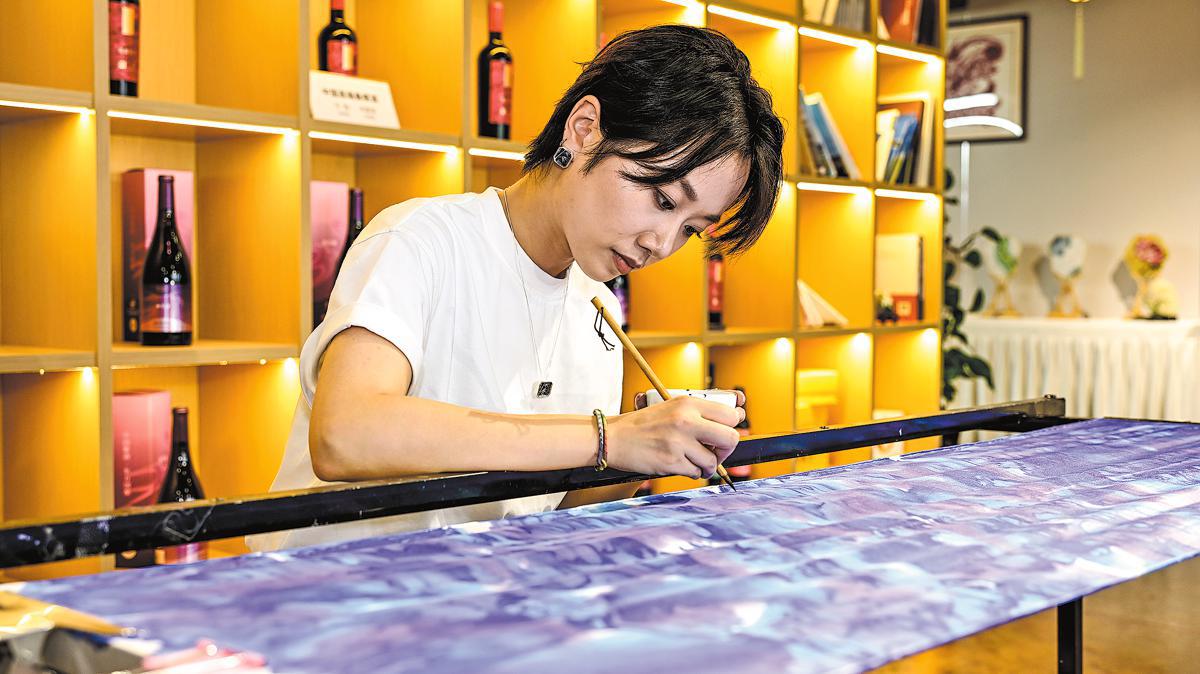Artist on a mission to promote Shu painting
Yu Xinxin's company in Sichuan province integrates traditional techniques with fashion design and AI
By Peng Chao in Chengdu | China Daily | Updated: 2025-07-31 08:51

In a workshop with a faint scent of dyes lingering in the air, Yu Xinxin holds a brush in hand, leaning forward slightly to add the final strokes to a painting on a piece of silk.
The Shu painting work named Lotus Rhyme, which took Yu over three months to finish, is scheduled to make its debut next month at the MAGIC Las Vegas, one of the largest sourcing expos for clothing, footwear and fashion accessories in the United States.
Shu painting, developed by artists in Nanchong, Sichuan province, since the 1970s, is a unique silk painting art that originates from ancient Chinese silk painting and incorporates traditional Chinese gongbi (meticulous brushwork) techniques. Shu is the ancient name for Sichuan.
As a fourth-generation inheritor of Shu painting, the 30-year-old Yu is trying to revive the fading art form by bringing it into the global spotlight.
She developed her love for silk culture from childhood. Her hometown Nanchong, known as a cradle of China's silk industry, has a 3,000-year history of planting mulberry and raising silkworms for silk production.
Her childhood memories are woven with the soft rustle of silkworms eating mulberry leaves, the shimmering silk flowing through the looms, and the dancing embroidery needle in her grandma's hands.
In high school, Yu learned basic skills of silk weaving and embroidery from her grandmother, which deepened her fascination with traditional craftsmanship.
While studying at the Sichuan Conservatory of Music, she spent much of her spare time learning about the history and culture of Shu embroidery, Shu brocade and Shu painting.
In 2022, a chance encounter connected Yu with Gao Zuoqing, the third-generation inheritor of Shu painting techniques.
"Seeing the colorful and lifelike Shu painting works in Master Gao's workshop, something inside me resonated with them — I couldn't take my eyes off them," she said.
When she learned that Shu painting was facing the challenge of having no inheritor, she decided to become an apprentice of Gao and systematically study the technique.
"What a pity it would be if such a beautiful intangible cultural heritage disappears!" Yu told herself.
The journey of learning turned out far more difficult than imagined, however.
A Shu painting artwork needs to go through over 10 processes before completion, including dye preparation, silk selection, painting, color fixation and rinsing, cutting, folding, and inlaying.
"Unlike painting on paper, numerous factors, such as the amount and concentration of dyes, the varying textures of silk, and the climate, air humidity, and temperature during the creation process, will affect the final outcome."
Yu lost count of how many times she failed before finally mastering the core techniques and principles of dye absorption on silk.
There is a patch of skin on her wrist with a different color. It was from an accidental scald while heating the dye — yet she kept practicing, and the dye stained the wound permanently.
During her learning process, Yu found that the traditional Shu painting craftsmanship faces a major challenge: due to the uneven absorption of dye across different parts of the silk, even experienced craftsmen achieve a success rate of only about 5 percent.
To address this challenge, she sought guidance through the China Silk Association and used modern technologies such as artificial intelligence to simulate dyeing effects under various conditions, ultimately raising the success rate to 70 percent.
After breaking through the technical bottleneck, Yu founded a company in 2024 and opened workshops in Nanchong and Chengdu, the Sichuan capital.
By integrating Shu painting techniques with fashion design and AI, her company developed a series of cultural and creative products and lifestyle products with the unique charm of Oriental aesthetics.
"Only by breaking free from traditional constraints can this ancient art truly become part of modern life," she said.
Today, more than 100 types of those products are sold overseas in countries including France, Japan and Turkiye.
To Yu's surprise, at an overseas exhibition, a jade bamboo-shaped necklace made by combining AI-generated patterns with Shu painting techniques won the favor of a French businessman, who placed an order for 500 pieces.
While running the company, a key focus for Yu is to inherit and promote Shu painting.
Considering that learning Shu painting requires a long time, great efforts, and significant investment in materials — factors that deter many young people — Yu is planning to set up workshops in universities to teach students who are interested. Currently, she has reached initial cooperation intentions with three universities.
Yu has also been promoting Shu painting by posting videos on short-video platforms and arranging study tours and exchange activities.
"Our workshop in Chengdu holds weekly salons, which are increasingly loved by young people," she said.
pengchao@chinadaily.com.cn
























